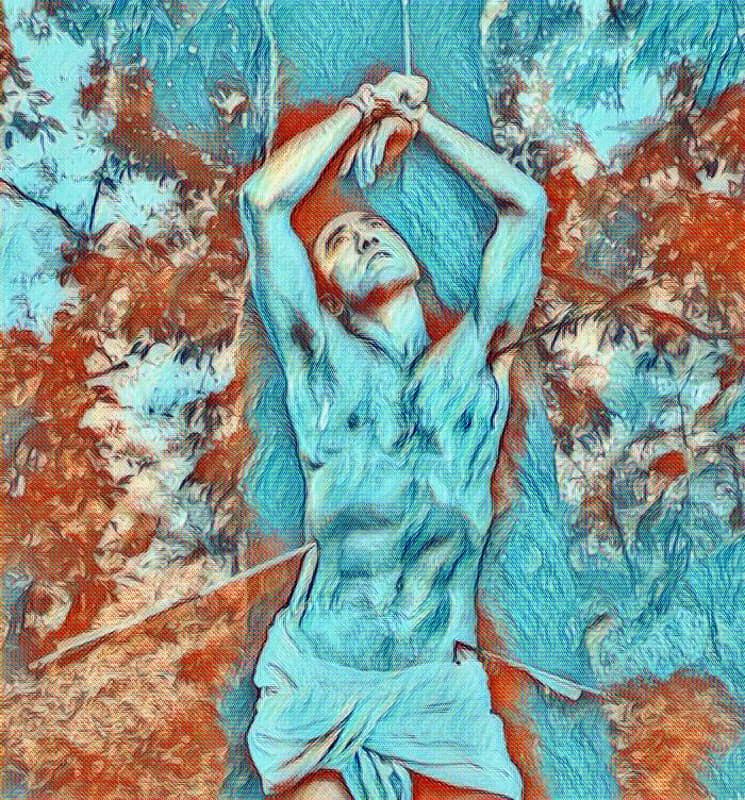If Yukio Mishima remains a key figure in Japanese literature and beyond, it is undoubtedly because he was able to weave a perfectly fitting samurai costume. The writer rejected the mechanization and modernization of Japan to the death. He embodies the spirit of sacrifice in the service of an age-old aesthetic and a nationalism rooted in the smoldering ruins of imperial Japan.
On November 25, 1970, after submitting the manuscript of his tetralogy to his publisher, The Sea of Fertility, and its fourth part, The Decay of the Angel (a somewhat clumsy translation after Marguerite Yourcenar, who suggested “the rotten angel”), Mishima went to the Ministry of the Army accompanied by three of his disciples. He took the General Commander-in-Chief of the Self-Defense Forces hostage and had the troops summoned. He made a speech in favor of traditional Japan and Emperor Hirohito. Very quickly, he was forced to give up in front of the hostile reaction of the soldiers. He then proceeded to his ritual suicide by seppuku, following the tradition of bushido (“the way of the warrior”), and was decapitated by one of his acolytes. More than a ritual suicide, it was a real ritualized and theatrical killing, because it was filmed and photographed. Until death, Kimitake Hiraoka remained Yukio Mishima; that is to say an artist, the “Japanese Jean Cocteau,”, as he was sometimes nicknamed. Marguerite Yourcenar even said that “Mishima’s death is one of his works and even the most prepared of his works.”
Born in 1925 in Tokyo, Mishima appears both as an anachronism, and as a synthesis of European and Japanese classical genius. It was perhaps even in the European classical genius that he found a hope to rectify a Japan that was modernizing (he wrote mainly in the 1950s and 1960s) and Americanizing at full speed (the country is a quasi-American protectorate since the Japanese defeat following the bombings of Hiroshima and Nagasaki). Mishima was therefore undoubtedly the last samurai of Japan. This is how he thought of himself, paying homage through his book on Japan and the Samurai aesthetic, a critical essay on Yamamoto Tsunetomo’s Hagakure. He was the last to have cultivated this synthesis of the literate spirit and the cult of the body.
Mishima’s Obsession with Death
Mishima was haunted by the idea of death as a memory. This can be seen in three major facts: the first is the memory of burned Tokyo, which did not begin to haunt him until many years after the end of the war. This vision, as well as the two American nuclear bombings on Hiroshima and Nagasaki, influenced Mishima’s entire generation, down to today, in cinema and literature. The bombings forged the relationship of the Japanese to the war, to the foreigner and to this brand new nuclear energy, in the Kaiju films, starting with the first of them, directed by Ishiro Honda in 1954, Godzilla (Gojira/ ゴジラ in Japanese).
Then, this culture of death also influenced and nourished him through his fascination with figures of European classicism—how can we forget the striking photo of Mishima as Saint Sebastian, hands tied, pierced with arrows, the body tense and muscular?
In the end, it was in the cult of the way of the samurai that he was able to find a means out of a Japan in decline. Mishima, a fearful, solitary child, refusing the modern Japan that was thrust on him, nevertheless decided to be a samurai of his time, the only authentic way for him to go his way and go to his end; by refusing modernization and mechanization, he chose the time and the way of his death. Between the code of chivalry, philosophy and religion, doesn’t the Hagakure say “I understood that the way of the warrior is death?” Every day, he “followed the way” and trained with a sword, even though the use of swords was forbidden at the end of the Edo period.
Therefore, how can we not understand his distress and anger, especially through his novel After the Banquet, which denounces the vanity of the behavior of the new Japanese bourgeoisie and especially the parliamentary system that Mishima hated. Similarly, in his novella, The Temple of the Golden Pavilion, he evokes themes of traditional Japan—beauty, ugliness and community.
In 25 years, Mishima wrote about a hundred works: plays, short stories, novels, essays. This is not the work of a man lost in an era that is not his own, wandering aimlessly, but that of a man who realizes that feudal Japan and the samurai are no more.
The Samurai and the Martyr: A Sense of Duty and Self-Improvement
But Mishima is also the paradoxical synthesis between Japanese samurai education and European classical literature. He loved Racine, Balzac, Shakespeare, Oscar Wilde and many others. In his quest for excellence and, again, for a lost ideal, since Europe had stepped into the midst of industrial and mechanical modernity, Mishima found a bridge in the figure of Saint Sebastian. Indeed, the Christian martyr, like the samurai, dies when his time has come, without shirking. Yamamoto Jōchō, in his Hagakure, writes: “True courage consists in living when it is right to live, and dying when it is right to die,” insisting precisely on the necessity to do one’s duty and not to run away from death. If the deep reason for Mishima’s morbid and almost erotic fascination with Saint Sebastian remains to be determined, the link between self-sacrifice and surpassing oneself, dear to the martyr and the samurai, undoubtedly enabled him to create this character, which is now almost mythical.
Antoine Pizaine is a historian, monarchist and Maurrassian. This article appears through the kind courtesy of PHILITT.
